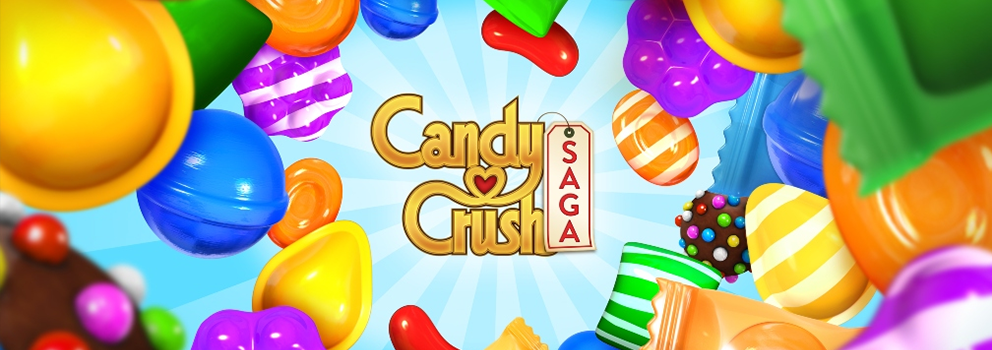
Candy Crush Saga is a mobile match 3 game released in 2012. I began my career in the games industry as a Level Designer on Candy Crush Saga from 2018 to 2020, after which I transitioned to Crash on the Run for two years. In 2022, I returned to Candy Crush and transitioned into my new role as a Gameplay Level Designer.
During my tenure I designed thousands of original levels along with maintenance of existing ones through design improvements, as well as difficulty tweaks based on player data. I was especially interested in puzzle design and often incorporated unconventional, gimmicky features into my levels while balancing understandability and visual clarity for a more casual player audience.
Additionally, I collaborated with meta feature development teams and led the design of new and innovative gameplay features that are still utilized in levels on a daily basis.
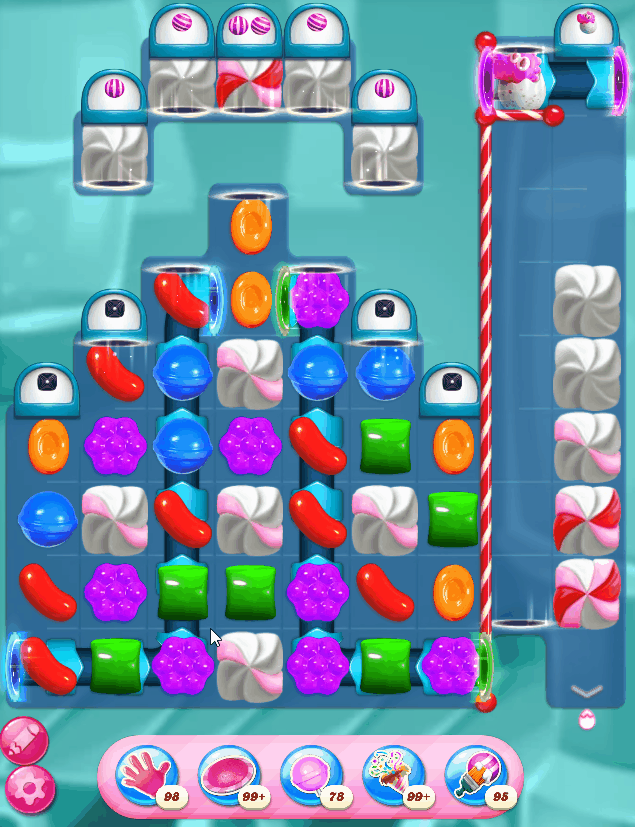
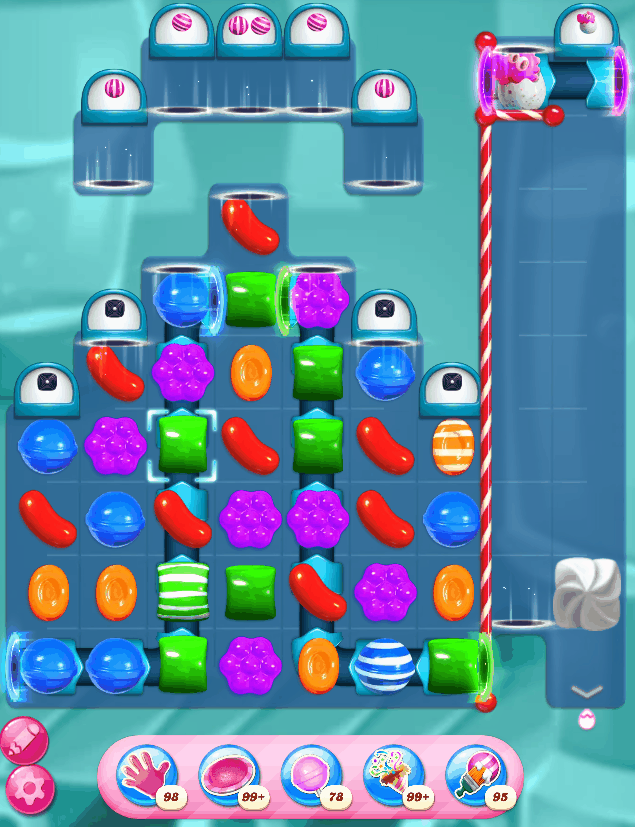
In this level, the main play area on the left allows the player to make moves that interact with the disconnected areas on the top and right sides of the level. The win condition is to bring the dragon down to the bottom right tile, but its path is blocked by frosting.
Each turn, a conveyor belt automatically pushes the dragon off the edge in an attempt to collect it, which succeeds as soon as the player removes all the frosting using striped candies that produce line blasts across the game board.
The player can create their own striped candies or remove the frosting from the upper area to unblock the striped candy cannons, making it easier to clear the frosting blocking the dragon’s path.
Once all the frosting is removed, the dragons are released onto the collection point one by one, serving as a fun reward for the player’s hard work.
I designed concepts for brief levels intended as bonus content that explored deeper gameplay mechanics, each with a very small number of moves. These levels emphasized the importance of executing moves in the right order and required a certain level of understanding of the game’s deeper mechanics. However, they were also designed to be easy enough that trial and error through multiple attempts could lead to success. Skilled players would be rewarded with the satisfaction of figuring out the solutions on their first attempt, while struggling players could learn more about the game’s deeper mechanics by paying attention to the outcomes of each move.
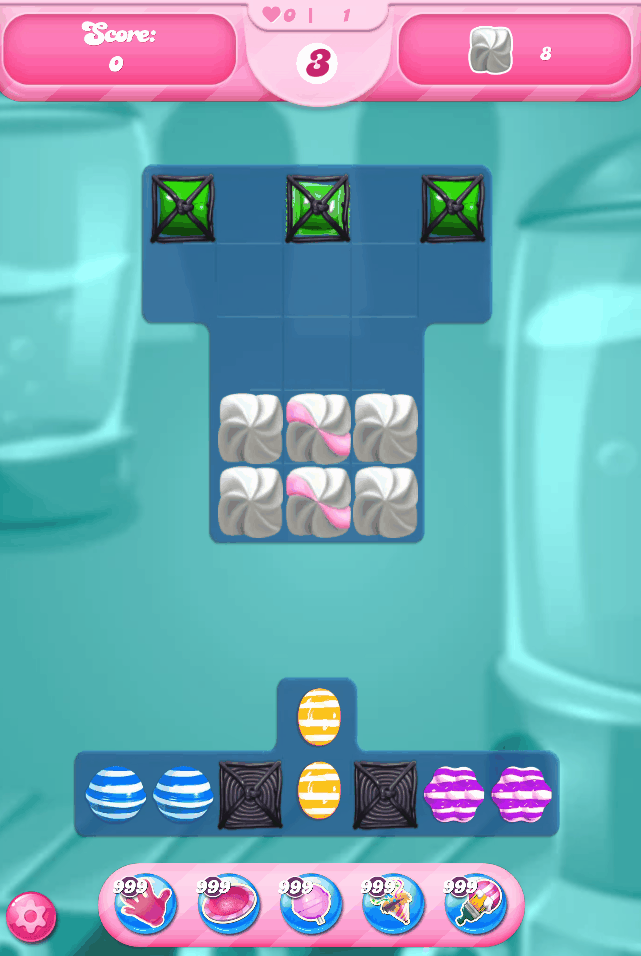
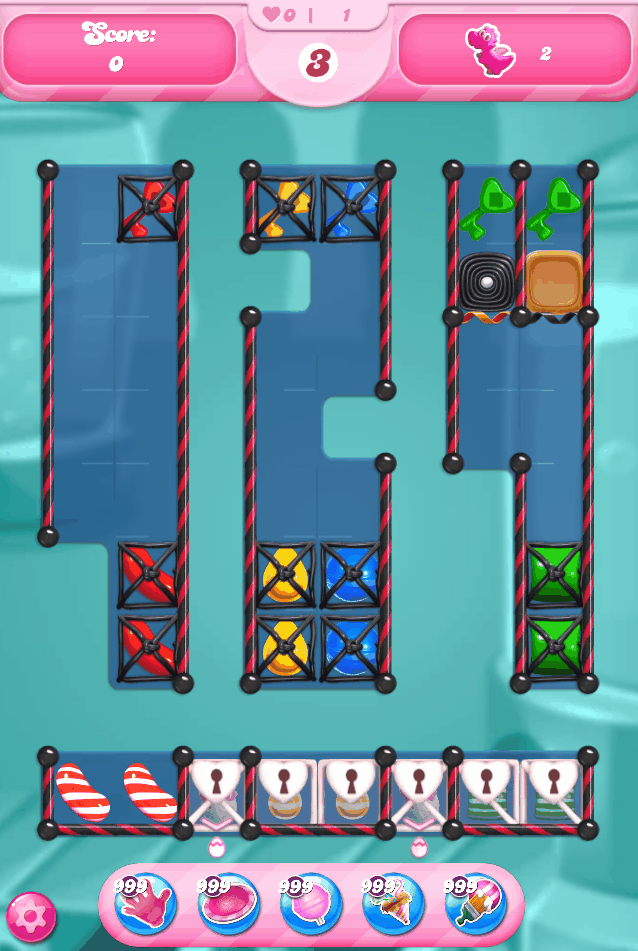
This was intended as the first bonus level of its type. The player only has three moves, and the solution should be clear to both beginners and pros alike.
When two striped candies are combined, a cross-shaped line blast is activated on the tile where the player moves the first striped candy. The challenge is to figure out the correct tiles and order to activate these cross-shaped line blasts, hitting the green candies and freeing them from their licorice locks.
Once all the green candies have been freed, they fall into a three-in-a-row pattern, activating the green wrapped candy which explodes twice, collecting all the frosting required to win the level.
In a later level, the concept of choosing the correct tile for the cross-shaped line blast returns in a more complex format.
Here, the player must pay attention to the placement of previously established gameplay features and choose between the left and right sides of three striped candy matches. Choosing the correct side frees a key, which falls down and automatically matches with its corresponding color, unlocking the next choice.
When three keys have been successfully matched, two Gummi Dragons are freed and automatically collected, fulfilling the winning condition and winning the level.
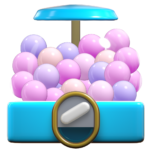

Role: Lead designer
Tasks: Ideation, conceptualization, design documentation, quality testing, tutorial level design, level design guidelines
Gameplay: YouTube
The Gumball Machine appears in levels where players need to collect Gumballs to win. Gumballs can be obtained by interacting with the Gumball Machine in several ways, including performing valid color matches (3 or more candies in a row) in adjacent tiles, hitting it with special candy effects like line blasts or explosions, and using boosters.
Each time the Gumball Machine is activated by the player’s actions, one Gumball is automatically collected. Once the required Gumball target amount is reached, all Gumball Machines on the game board disappear, leaving their tiles open for other board items.
During development, I tested the disappearing mechanic as a potential extension to the core Gumball collection behavior. This mechanic made it into the final product, providing additional utility for level designers. It can be used as a progression gate, keeping certain areas of the levels inaccessible until the player collects the required number of Gumballs.
Role: Lead designer
Tasks: Ideation, conceptualization, design documentation, quality testing, tutorial level design, level design guidelines
Gameplay: YouTube
The Rainbow Twist is an interconnected set of layered obstacles linked together to form a chain. Destroying any one of them destroys the whole chain. However, Rainbow Twists encased by locks such as the Licorice Lock or Marmalade are not considered part of the chain. Once freed, they automatically link up with any Rainbow Twists in adjacent tiles. “Wall” features such as the Licorice Fence interrupt the connection between Rainbow Twists and prevent them from being destroyed together.
This feature was inspired by the Licorice Link from Candy Crush’s sequel games. Initially, we aimed to retain the feature’s original behaviors, but I saw an opportunity for improvement. I interviewed teams familiar with the Licorice Link to identify key areas for enhancement and proposed my ideas for added lock and wall dynamics. As a result, the Rainbow Twist features an additional layer of durability (5) and incorporates the proposed lock and wall mechanics.


Role: Lead designer
Tasks: Ideation, conceptualization, design documentation, quality testing, tutorial level design, level design guidelines
Gameplay: YouTube
The Licorice Fence is a “wall” feature that occupies the space between game board tiles. These walls are designed to protect tiles on the game board and can be used as a construction tool to block off areas and prevent colored candies from matching.
The Licorice Fence also blocks special effects, meaning that most explosions and line blasts produced by other board items can’t pass through it. Its sister feature, the Licorice Curl, has up to three layers and can be removed from the game board.
Unlike its precursor, the Candy Cane Fence, which doesn’t block special effects, the Licorice Fence addressed a long-discussed need within the level design team. Walls had already proven their incredible usefulness by saving valuable space on the game board, as tiles couldn’t be separated without sacrificing entire tiles before walls were introduced. Additionally, to block special effects, a full tile was required. In contrast, the Licorice Fence provides the same effect while effectively using negative space.
Role: Supporting designer
Tasks: Ideation, conceptualization, design documentation, quality testing
Gameplay: YouTube
The Sugar Coat is a type of lock that encases mobile board items. It moves with the encased item around the board and protects it from all types of damage up to three times before disappearing. After the Sugar Coat disappears, the item inside is freed and can be used as usual.
The feature started as an idea for a mechanic that would protect mobile board items, as all previous locks would keep their encased items static. Theoretically, this would allow board items to travel further on the game board without being easily destroyed, enabling designers to create challenges where the player needs to escort special items to specific areas on the board without worrying as much about destroying them.
While I did not lead the development of this feature, I thoroughly conceptualized it before collaborating with another designer who brought it to completion. I am proud that the final implementation closely followed my initial specifications, showcasing the effectiveness of our teamwork and the strength of the original concept.